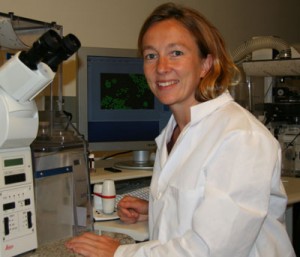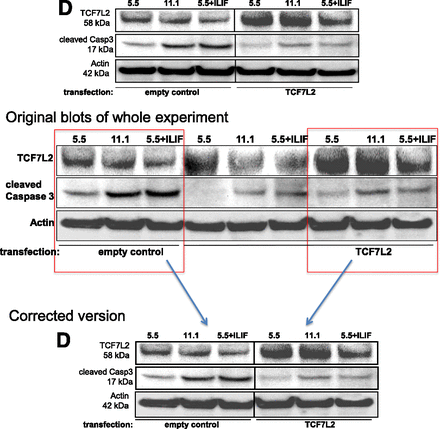
Prominent German diabetes researcher Kathrin Maedler has issued corrections on two papers, and told Retraction Watch she is in the process of defending the data on others.
14 of her papers have been critiqued by PubPeer commenters. The commentary, which spans from her graduate work in 2002 to a 2014 publication in Nature Medicine, includes questions about image manipulation and self-plagiarism.
Laborjournal’s blog (we have a column in their English-language publication) first flagged these suspicions in July 2014, after being approached by pseudonymous Clare Francis.
Here’s a comparison between figures in Maedler’s 2009 PLoS One paper, “Deletion of the Mitochondrial Flavoprotein Apoptosis Inducing Factor (AIF) Induces β-Cell Apoptosis and Impairs β-Cell Mass,” and one she co-authored in 2006 in Diabetes, “Low concentration of interleukin-1beta induces FLICE-inhibitory protein-mediated beta-cell proliferation in human pancreatic islets,” via PubPeer:
Other groups have failed to replicate Maedler’s findings, despite clinical trials based on them, as discussed in this 2005 article in Diabetes:
Most of the data supporting this novel hypothesis have been generated by one research group [Maedler’s], and based on these findings, a clinical trial has been initiated using interleukin-1 receptor antagonist (IL-1ra) to prevent B-cell death in type 2 diabetic patients. Of concern is, however, that other groups have failed to reproduce in rodent models the key findings of this unifying hypothesis for B-cell death in diabetes.
We asked Maedler about these issues. She told us about this correction published in November in Diabetes, for “Transcription Factor 7-Like 2 Regulates β-Cell Survival and Function in Human Pancreatic Islets,” which reads:
The authors of the above-cited work have noticed that one actin panel, which was used to confirm similar protein loading across the Western blot gel, was mistakenly used in Fig. 5D. At the time of publication, many similar experiments were done, and Western blot analyses of TCF7L2 upon upregulation by TCF7L2 overexpression were performed. Corresponding actin blots were very similar and thus were mistakenly switched.
The figures below show the initial Fig. 5D, as well as the original blots of the whole experiment together with the correct actin blot, which corresponds to the respective experiment. TCF7L2 as well as Caspase-3 blots were correct and remain unchanged.
The authors apologize for the mistake and any inconvenience it may have caused the readers.
The paper has been cited 135 times, according to Thomson Scientific’s Web of Knowledge.
She also told us that a correction to this PLoS ONE paper will be out in the next week or so. That paper has been cited 13 times.
As for the other papers, she said that her lab could prove that the data was correct, but due to her lab moving twice since 2008, it will take some time.


2000-2002: Ph.D. thesis at the Division of Endocrinology and Diabetes, University Hospital Zurich, Switzerland. Thesis: “Lipo-and Glucotoxicity on human pancreatic islets”
———————
PhD is two years. How common is that in Europe?
Probably closer to three years, which is average for Switzerland.
Three years for a PhD in “Life Science” (in the broad meaning of the term) is not average in Switzerland these days, most people now take 4 years or longer even though the PhD programs are usually set out for 3 years.
Two years seems extremely short, but perhaps her prior degrees as a pharmacist and some more postgraduate work in London were recognized and credited.
According to http://www.uzh.ch/about/faculties/promotionen/2003/promo-2003-05.pdf she got her Ph.D. in May 2003.
she said that her lab could prove that the data was correct, but due to her lab moving twice since 2008, it will take some time.
Huh? That makes no sense at all.
PhD is two years. How common is that in Europe?
Not impossible, but certainly unusual. Three to four years is typical.
It is three years. 2000-2002, i.e. 200-2001-2002
Theoretically it could have been 13 months, December 2000-January 2002.
True, better than Ariel!
Meantime, a journal on diabetes finds “no problems” with duplicated images on the paper below:
https://pubpeer.com/publications/DAE3F446AF7669736A28A4DA9EAD4E
At least then we know which venues to chose.
Dear CR,
The comments on this article from the same group are also interesting:
https://pubpeer.com/publications/FC6FB9DF824662F15BF5D764904480
Specially if you consider that the funding agency (FAPESP – from the government of the state of São Paulo, thus public) provided R$ 4,358,311.37 (about USD 1,600,000)…
http://revistapesquisa.fapesp.br/2012/08/15/a-trama-por-tr%C3%A1s-do-diabetes/
By the way, the article was published in Diabetes (IF 8.3)
Double specially considering this was the first group to formally threaten Science Fraud blog for openly discussing “curi”osities on their papers… About the $$, I must say that by that time it was worth over 2 million dollars (the Real has steeply devalued since then) and we have even much greater sums spent on other dubious projects, such as Nicolelis’ Walk Again. Grants of around 1 million dollars up to now have been common to “1A” researchers such as Curi/Saad.
PloS ONE paper: Mouse WT and Mouse Hq actin bands are almost on the same height, while the actin band of siFLIP is lower compared to siScr. Seems very unlikely that the same actin blot was used in both papers.
Have you thought about one or two dimensional transformations. For example vertically stretching?
Figure 1A has been corrected.
13th November 2015 retraction.
http://www.jbc.org/content/290/46/27532.full
Another K Maedler publiation under scrutiny at Pubpeer:
https://pubpeer.com/publications/19396427
2018 expression of concern for
Diabetes. 2006 Sep;55(9):2455-62.
Aging correlates with decreased beta-cell proliferative capacity and enhanced sensitivity to apoptosis: a potential role for Fas and pancreatic duodenal homeobox-1.
Maedler K1, Schumann DM, Schulthess F, Oberholzer J, Bosco D, Berney T, Donath MY.
Author information
1
Larry L. Hillblom Islet Research Center, University of California, Los Angeles, USA.
2018 notice.
http://diabetes.diabetesjournals.org/content/early/2018/09/11/db18-ec2018a.long
2018 update to expression of concern for
Diabetes. 2006 Oct;55(10):2713-22.
Low concentration of interleukin-1beta induces FLICE-inhibitory protein-mediated beta-cell proliferation in human pancreatic islets.
Maedler K1, Schumann DM, Sauter N, Ellingsgaard H, Bosco D, Baertschiger R, Iwakura Y, Oberholzer J, Wollheim CB, Gauthier BR, Donath MY.
Author information
1
Larry L. Hillblom Islet Research Center, University of California, Los Angeles, CA, USA.
2018 notice.
http://diabetes.diabetesjournals.org/content/early/2018/09/11/db18-ec2018b.long